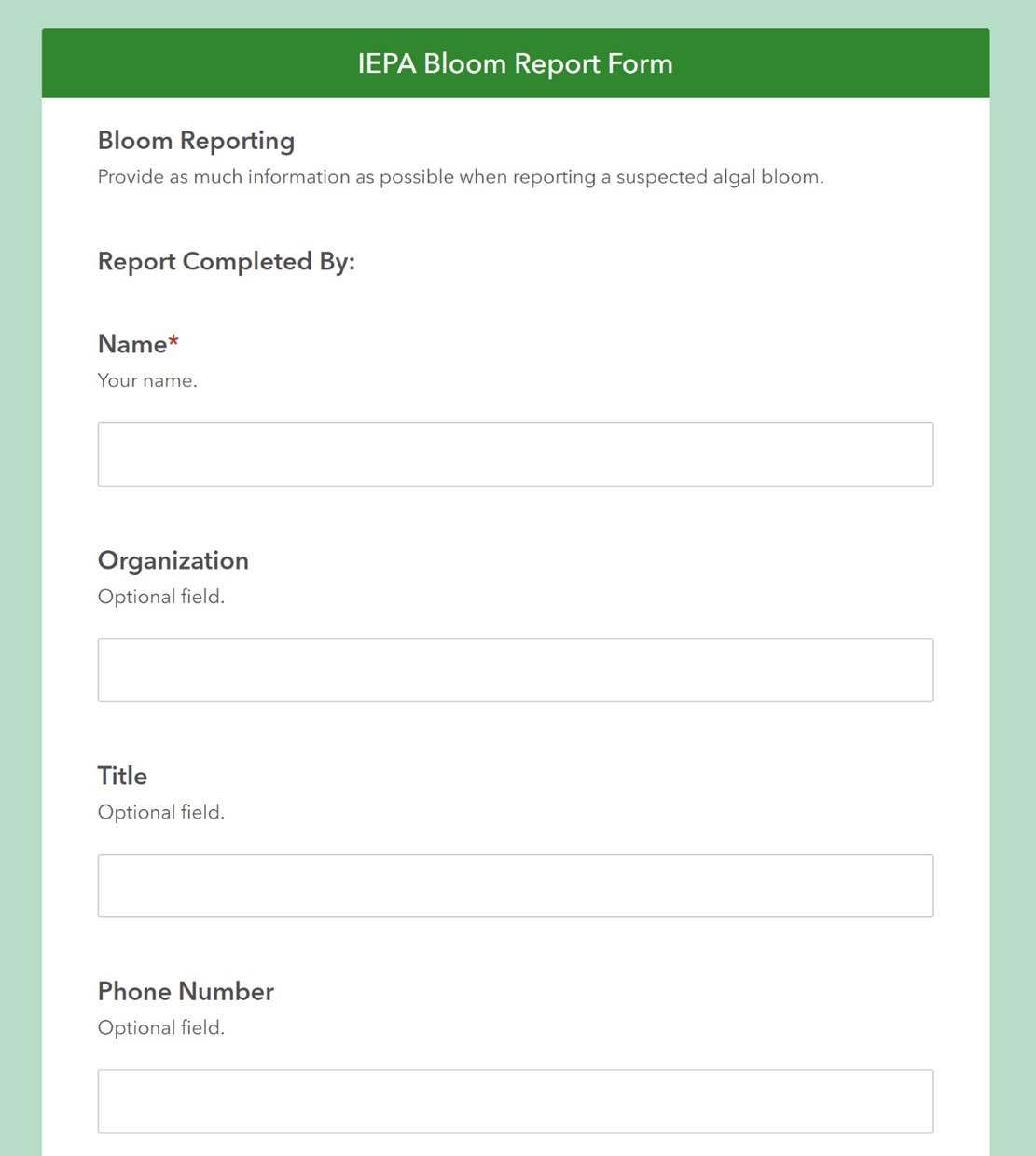Reporting a Harmful Algal Bloom
Do you suspect a blue-green algae bloom in your lake or in a public lake you've visited?
If yes, Use the New IEPA Bloom Report Form App (accessible on computer or phone).


OR
Fill out a Bloom Report Form. (Google Chrome users: You may need to download the form first before opening it. Right-click the link and select "Save link as..." from the menu.)
- Bloom Report Form (Manually Fill) - or print, manually fill out, and scan in completed form.
- Fill out as much of the form as possible.
- Take two photographs of the bloom. One photo should be a close-up of the algal bloom or scum and the other photo should include the surrounding landscape to help identify the location of the bloom or scum on the lake.
- Submit the form with copies of the pictures to EPA.HAB@illinois.gov
In addition, you may report suspected blooms via U.S. EPA's BloomWatch app report on your smartphone. See the BloomWatch Quick Start Guide for instructions.

For more information: https://cyanos.org/bloomwatch/#bloomwatch_ho
Contacts
What Happens Next?
Note: Someone at the Illinois Environmental Protection Agency (Illinois EPA) will review all forms submitted. After review, information submitted via the bloom report form may be displayed on the Illinois EPA Algal Bloom Dashboard. Note: The ability to initiate follow-up activities will be dependent on time and resources of the Illinois EPA at the time of the submittal. Priority will be given to publicly owned lakes.
If the Bloom Report and photos support the occurrence of an actual blue-green algae bloom, a responder may be sent to investigate the bloom. The responder could be an Illinois EPA employee or someone designated by Illinois EPA. Illinois EPA will be able to send responders only as time and resources allow.
If a responder is sent to investigate, they will attempt to contact the person reporting the bloom for additional current information about the bloom. They may also visit the lake to collect a sample for analysis of microcystins. A screening test for microcystins may also be conducted. Results of screening tests are usually available within 24-36 hrs. If microcystins are detected above concentrations of concern, the person reporting the bloom and the lake manager will be notified.
A sample may also be sent to the Illinois EPA laboratory for quantitative analysis (with a longer turn-around for results). Results will be provided to the person reporting the bloom and the lake manager, if known.
Illinois EPA will not issue an advisory or close a lake due to microcystin concentrations that exceed USEPA’s draft swimming advisory threshold (see below). Illinois EPA will provide information to the lake manager or homeowner, and may make recommendations on lake usage. With information in hand, the lake manager or homeowner’s association, at their discretion, may choose to post an advisory (or close a portion of the lake), warning people of the elevated microcystin levels in the lake.
Follow-up qualitative or quantitative samples may be taken, on a site-specific basis, as time and resources allow.
Interpreting Results
In May 2019, the United States Environmental Protection Agency published recommended values for two cyanotoxins, microcystins, and cylindrospermopsin under the Clean Water Act section 304(a) for states to consider as the basis for swimming advisories for notification purposes to protect publich health in recreational waters (see Table 1). The values are recommended thresholds that are not to be exceeded on any day.
Table 1. Recomended Magnitutde for Cyanotoxins
| Microcystins |
Cylindrospermopsin |
|---|---|
| 8 µg/L a | 15 µg/L a |
a. Swimming Advisory: not to be exceeded on any day.
Safety
Use caution around water containing a possible harmful algae bloom. People and pets should avoid direct contact to, inhaling droplets of, or ingesting any of the water. When working near or investigating a bloom, safety equipment including: gloves, carpenter’s mask, waders, goggles, and personal flotation devices are recommended. If you or your pets come in to contact with surface water exhibiting signs of a potential harmful algae bloom, wash immediately with soap and tap water.
Reporting Human Illness
Groups of people who experience illness with similar symptoms after swimming in recreational water should report this to their local health department for follow-up.
References
Chorus I, Bartram J. 1999. Toxic cyanobacteria in water: a guide to their public health consequences, monitoring and management. World Health Organization.
Graham JL, Loftin KA, Kamman N. 2009. Monitoring recreational freshwaters. LakeLine 29:18–24.

